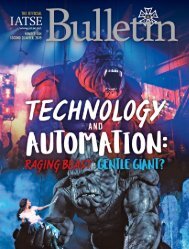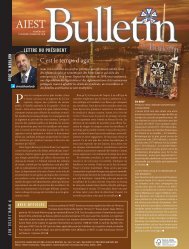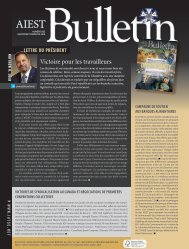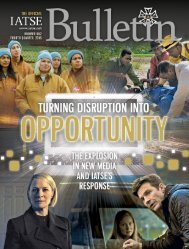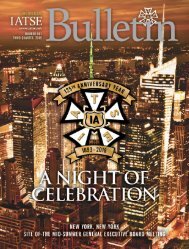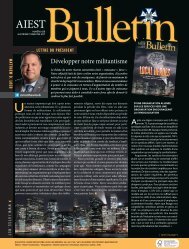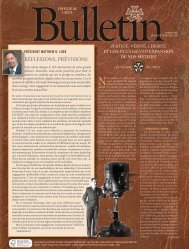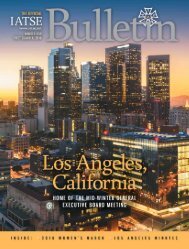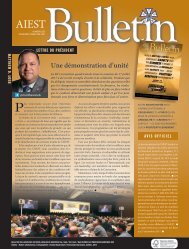IATSE-2nd2018_web
You also want an ePaper? Increase the reach of your titles
YUMPU automatically turns print PDFs into web optimized ePapers that Google loves.
population was still extremely small, and the government<br />
wanted to speed up the settlement process throughout the vast<br />
mid section of the nation.<br />
Over the next few decades, they sponsored or produced<br />
many movies depicting the beauty of Canada. The Canadian<br />
Pacific Railroad established a Colonization Department, which<br />
sponsored thirteen one reel films, eleven of them dramatic, to<br />
promote immigration.<br />
The first dramatic film made in Canada was Hiawatha, the<br />
Messiah of the Ojibways. This 800-foot reel was directed and<br />
photographed by Joe Rosenthal and was the brainchild of E.A.<br />
Armstrong of Montreal.<br />
Before the shift toward California, many American<br />
filmmakers saw the promise of the beautiful Canadian landscape<br />
and turned their attention northward.<br />
By 1913 American producers had begun tapping the Canadian<br />
repertoire of films, releasing many of the dramatic productions<br />
made by <strong>IATSE</strong> brothers and sisters in the North. While there<br />
were frequent and frustrating labor disputes in Canada, their<br />
entertainment industry pioneers were independent and creative<br />
individuals who were generally spared the strife and turmoil that<br />
dominated Hollywood.<br />
THE LURE OF HOLLYWOOD<br />
Initially, making movies in New Jersey was fine, but as the<br />
demand for movies increased, the unpredictable weather and<br />
long winter days when sunlight was at a minimum became more<br />
of a problem. The industry had not yet perfected the lighting<br />
techniques which would make filming easier later on. Quite<br />
simply, they needed better weather.<br />
In addition some directors and producers were anxious<br />
to move away from the East because they were being harassed<br />
by the Edison Company, which held the patents on movie<br />
cameras. Edison expected large royalties from those companies<br />
using his camera. But the small start-up companies could not<br />
afford to pay, so they began to look for other options.<br />
The abundant sunlight, little rain, and wide-open spaces<br />
of sunny California beckoned. Westerns shot on location were<br />
becoming increasingly popular, and the unpopulated outskirts<br />
of Los Angeles provided a perfect setting.<br />
Unfortunately, it was appealing to motion picture-makers for<br />
another reason: Los Angeles had a history of being a staunchly<br />
“open shop” city. Southern California labor unions were among<br />
the most hard-pressed of any in the country. This struggle went<br />
on for several decades while the city of Los Angeles went through<br />
a series of economic booms and busts.<br />
A small group of men, led by General Harrison Gray Otis,<br />
publisher of the Los Angeles Times, created the Chamber of<br />
Commerce to address the economic decline of the city. They did<br />
what they could to lure businesses to town. And that included<br />
keeping wages down and busting unions.<br />
They also recruited new residents from the East to stimulate<br />
real estate sales and glut the labor pool. This artificially large<br />
labor pool was estimated to keep wages as much as forty percent<br />
lower in Los Angeles than in San Francisco.<br />
Central to this plan was ensuring that labor in Los Angeles<br />
remain unorganized. In 1896, Otis and other business leaders<br />
formed the Merchants and Manufacturers Association (M&M)<br />
and through the L.A. Times venomously attacked organized labor.<br />
But this highly-organized and hateful opposition did not<br />
prevent the theatrical workers from forming the Los Angeles<br />
Theatrical Workers Union in 1891 and joining the Alliance in 1896.<br />
The labor situation came to a head in 1910 when M&M<br />
managed to ram through an anti-picketing ordinance through<br />
the L.A. City Council. In a short time, 470 workers were arrested<br />
for picketing. However, the public sympathized with the strikers<br />
and juries released the defendants almost as quickly as they were<br />
arrested.<br />
17




